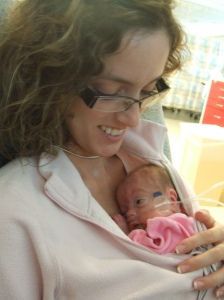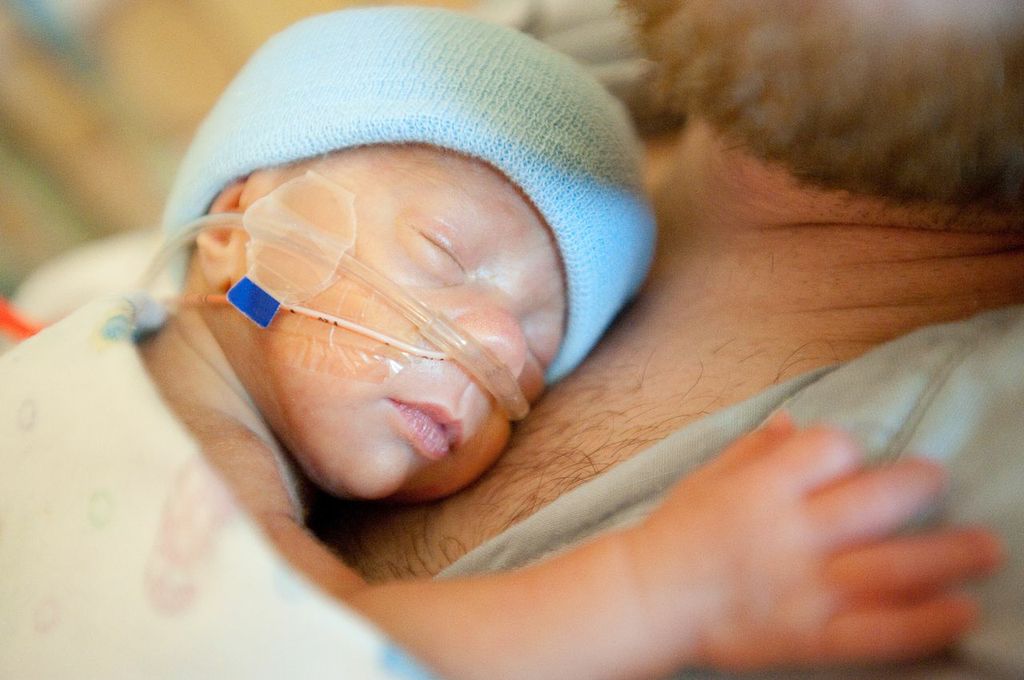
Photo credit: Alter Family
Kangaroo care is a form of developmental care that has benefits for all newborns, especially those who are in the neonatal intensive care unit. Also known as skin-to-skin contact or kangaroo mother care, kangaroo care involves direct contact when a newborn is placed skin-to-skin on mom or dad’s bare chest. Mom or dad may gently hold their baby where they can be rocked, cuddled and hear comforting sounds of their parent’s heartbeat and voice. Even in the stressful environment of the NICU, parent and child can quietly bond and get to know one another. Kangaroo care is easy to do, inexpensive and highly rated by parents 4.
Benefits for Baby
Many of the benefits of kangaroo care to a newborn revolve around their feelings of safety, warmth and comfort. Research shows greater bonding with parents and as a result more calm and less stress2, which positively impacts their brain and emotional development1.
Kangaroo care can help NICU babies
- Regulate their heart rate, breathing and temperature2
- Improve head circumference growth and weight gain2,4,5
- Stabilize their organ function and self-regulation abilities1,3
- Experience less pain and less crying6
- Facilitate better sleep patterns1
- Avoid infections2,4,5
- Take advantage of improved nutrition from mothers’ increase in breastmilk production1,2
- Be more willing to breastfeed2,4,5
- Enjoy a shorter hospital stay7
In addition to benefits that are observable in the NICU, research points to long-term advantages as well. Newborns who experienced kangaroo care in the NICU were more attached and bonded to their mothers over time. Babies were more alert after six months and their mothers were more attuned to their infant’s cues and experienced less depression1. In early childhood, children receiving kangaroo care also show increased social competence, a positive sense of self and improved cognitive and motor development 1,4. These benefits are all signs of healthy brain development. In 2016 a study was released that revealed kangaroo care held significant, long-lasting social and behavioral protective effects even 20 years later.8

Photo credit: Beverly Demafiles Photography
When to Start Kangaroo Care
Depending on your baby’s condition, kangaroo care can begin immediately after delivery or may start after they are more stable. Even very small babies with major health issues or on a mechanical ventilator can benefit from these short sessions. Once your baby is stabilized, sessions should be at least an hour (even up to 24 hours though NICU policies vary) as anything less can be stressful for your baby2. Your nurse or other neonatal professional should be able to give advice about when a baby is ready for kangaroo care and help prepare parents for this special time together.
Getting Ready for the Big Moment
Kangaroo care usually requires a comfortable place to sit with several pillows for support and to help position the baby, though it can also be done standing up. Many hospitals provide a privacy curtain or screen to make it easier for a parent to undress from the waist up to prepare to hold their child. If a privacy screen is not available, parents may be offered a wrap or a stretchy shirt with a large neck opening that can be worn with space for baby to be tucked inside for privacy.
During kangaroo care, a baby will be undressed down to the diaper and placed directly on mom or dad’s chest. Any wires or tubes will be carefully positioned, and parent and child will be covered with a lightweight blanket or wrap to stay warm and for privacy. The nurse will likely take your baby’s temperature several times to make sure they are maintaining their temperature and will probably watch the monitors pretty closely the first few times.
NICU moms share how Kangaroo Care made them feel
“Like I was able to serve a purpose for her. If I couldn’t hold her on the inside, I was going to do all I could on the outside.” ~Orva-Lee J.
“Wonderful, connected, close, calm, almost like a normal mom (minus all those wires)” ~Heather C.
“Hopeful. I could see on the monitors when holding my twins that everything would level out with them. It really made a difference.” ~Jennifer D.
“Truly like my son’s mom….not just a visitor. Some of my most cherished moments early on in our NICU stay.” ~Alicia G.
Mothers Bond with Their Babies
The transition from pregnancy to a birth with complications and caring for a child in the NICU can be traumatic and stressful. Feelings of anxiety, fatigue, anger, guilt and depression, all emotions which can impact a mother’s confidence to interact with their baby, are common1. Meeting the instinctual need to hold and soothe a newborn with kangaroo care helps mothers feel needed and re-connected to their baby, which melts away stress and leaves them feeling more fulfilled and empowered2. In addition, research shows mothers find it easier to bond with their infant, improving their ability to care for a medically fragile child3,5.
Dads Have a Role to Play, too
It is not uncommon for dads to feel like a visitor or spectator when their baby is in the NICU3. Moms often spend more time in the NICU and have the role of providing breast milk. Kangaroo care can empower dads so they also feel like a significant person in their infant’s life. Fathers also learn specific knowledge about caring for their baby, become a part of their schedule, and gain the nursing staff’s confidence as well by participating in skin-to-skin care3. Kangaroo care is a great time for dads to practice practical skills related to caring for their child, while building a lasting bond.
Many times it feels that there are very few things you can do for your baby while in the NICU. Kangaroo care can be an opportunity for mothers and fathers to do something positive for their precious newborn. Kangaroo care is a great time to talk softly, sing or hum quietly to your baby, or sit quietly and be grateful for the small things. Ignore the monitors and concentrate on the feeling of your baby’s skin, her breath, her smell, the sweet noises, the weight of her on your chest. This is a precious moment and that hour will fly by. Before you know it you will be asking when can I do it again?
Sources
1Neu, M. & Robinson, J. (2010). Maternal holding of preterm infants during the early weeks after birth and dyad interaction at six months. Journal of Obstetric, Gynecologic, & Neonatal Nursing, 39, 401-414; DOI: 10.111/j.1552-6909.2010.01152.x.
2World Health Organization. (1993). Kangaroo mother care: a practical guide. Retrieved July 12, 2013 from
https://www.who.int/maternal_child_adolescent/documents/9241590351/en/
3Helth, T. D., Jarden, M. (2013). Fathers’ experiences with the skin-to-skin method in the NICU: Competent parenthood and redefined gender roles. Journal of Neonatal Nursing, 19, 114-121.
4Blacke, J. & Gregson, S. (2011). Kangaroo care in pre-term or low birth weight babies in a postnatal ward. British Journal of Midwifery, 19, 9, 568-577.
5Blomqvist, Y. T., Flolund, Nyqvist, K. H., & L., Rubertsson, C. (2012). Provision of Kangaroo Mother Care: supportive factors and barriers perceived by parents. Caring Sciences, 27, 345-353.
6Academy of Breastfeeding Medicine. (2010). Clinical Protocol Number #23: Non-pharmacologic
management of procedure-related pain in the breastfeeding infant. Breastfeeding Medicine 5(6), 1-5. DOI:
10.1089/bfm.2010.9978
7Charpak N., Ruiz-Peláez, J. G., Figueroa de C. Z., & Charpak, Y. (1997). Kangaroo mother versus traditional care for newborn infants </=2000 grams: a randomized, controlled trial. Pediatrics. 100(4):682-8.
8AAP News. (2016). Twenty-year Follow-up of Kangaroo Mother Care Versus Traditional Care. Retrieved January 4, 2016, from https://pediatrics.aappublications.org/content/139/1/e20162063.
